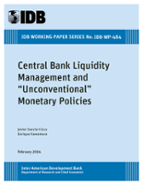Central Bank Liquidity Management and "Unconventional" Monetary Policies
Date
Feb 2014
This paper presents a small open economy model to analyze the role of central bank liquidity management in implementing "unconventional" monetary policies within an inflation targeting framework. In particular, the paper explicitly models the facilities that the central bank uses to manage liquidity in the economy, which creates a role for the central bank balance sheet in equilibrium. This permits the analysis of two "unconventional" policies: sterilized exchange-rate interventions and expanding the list of eligible collaterals accepted at the liquidity facilities operated by the central bank. These policies have been recently implemented by several central banks: the former as a way to counteract persistent appreciations in the domestic currency, and the latter as a response to the recent global financial crisis in 2008. As a case study, the paper provides a detailed account of the Chilean experience with these alternative tools, as well as a quantitative evaluation of the effects of some of these policies.



